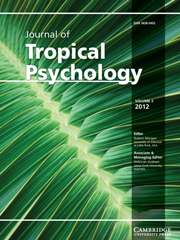No CrossRef data available.
Article contents
The Future Will Be Better Tomorrow
Published online by Cambridge University Press: 29 June 2017
Extract
It was 2012 in Singapore. There I saw a young boy in a mall wearing this hopeful T-shirt message: “The future will be better tomorrow.” This paradox of incidental wisdom suggests that our future path can be changed and we are the artists.
- Type
- Articles
- Information
- Copyright
- Copyright © The Author(s) 2017
References
Fouts, R. (2003) Next of Kin: My conversations with Chimpanzees. New York: Quill/HarperCollins.Google Scholar
Morgan, R.F. (2015) Climate change in a multinomial world. Journal of Tropical Psychology, 5, 2015, Cambridge University Press.Google Scholar
Morgan, R.F. (2012) Trauma Psychology in Context: International Vignettes and Applications from a Lifespan Clinical-Community Psychology Perspective. Santa Cruz, CA: Sentinal/Morgan Foundation.Google Scholar
Morgan, R.F. (2005a) The Iatrogenics Handbook: A Critical Look at Research & Practice in Helping Professions. Albuquerque, NM: Morgan Foundation.Google Scholar
Morgan, R.F. (2005b) Training the Time Sense: Hypnotic & Conditioning Approaches. (With Cooper, Linn, Erickson, Elizabeth, Erickson, Milton, Marshall, Gary, Maslach, Christina, Sacerdote, Paul, & Zimbardo, Phillip). Albuquerque, NM: Morgan Foundation.Google Scholar
Morgan, R.F. (1965) Temporal conditioning in humans as a function of inter-trial interval and stimulus intensity. Dissertation Abstracts, 37, No. 66–6153. From R. Morgan's Ph.D. dissertation, Michigan State University, 1965.Google Scholar
Morgan, R.F. (1964) A galvanic skin response technique for the sensory evaluation of annelids. Michigan Academy of Science Papers, 50, 337–342.Google Scholar
Morgan, R., Ratner, S.C., & Denny, M.R. (1965) Response of annelids to light as measured by the galvanic skin response. Psychonomic Science, 3, 27–28. From R. Morgan's master's thesis, Michigan State University, 1964.Google Scholar
Morgan, R.F. & Wilson, J. (2005) Growing Younger: How to Measure and Change Your Body's Age. Albuquerque, N.M.: Morgan Foundation.Google Scholar
Ratner, S.C. & Denny, M.R. (1964, 1970) Comparative Psychology: Research in Animal Behavior. Belmont, CA: Dorsey.Google Scholar
Schardt, D. (2006) Helpful bacteria: Should you take probiotics?
Nutrition Action Health Letter of the Center for Science in the Public Interest, 33
(10) December, 7–9. Cf. Vaccine online (doi:10.1016), J. Vaccine.2006.05.048, American Journal of Gastroenterology, 101: 812, 2006.Google Scholar




